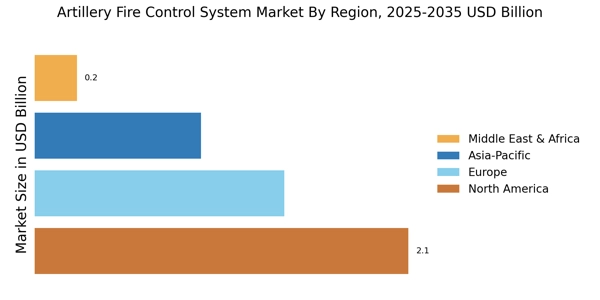Rising Geopolitical Tensions
The Artillery Fire Control System Market is experiencing growth due to escalating geopolitical tensions across various regions. Nations are increasingly investing in advanced military capabilities to enhance their defense strategies. This trend is particularly evident in areas with ongoing territorial disputes or military conflicts, where the need for precise and effective artillery systems becomes paramount. As countries seek to modernize their armed forces, the demand for sophisticated fire control systems is likely to rise. Recent data indicates that defense budgets in several nations have seen an uptick, with a notable portion allocated to artillery modernization programs. This shift suggests a robust market potential for companies specializing in artillery fire control technologies.
Growing Demand for Precision Warfare
The growing demand for precision warfare is a critical driver in the Artillery Fire Control System Market. As military strategies evolve, there is an increasing emphasis on minimizing collateral damage while maximizing operational effectiveness. Artillery fire control systems play a vital role in achieving these objectives by providing accurate targeting and improved situational awareness. The trend towards precision-guided munitions further amplifies the need for sophisticated fire control systems that can effectively integrate with these technologies. Market analysis indicates that the demand for precision artillery systems is on the rise, as armed forces seek to enhance their capabilities in complex operational environments.
Integration of Advanced Technologies
The integration of advanced technologies into the Artillery Fire Control System Market is a significant driver of growth. Innovations such as artificial intelligence, machine learning, and enhanced sensor technologies are transforming traditional artillery systems into highly efficient and accurate platforms. These advancements enable real-time data processing and improved targeting capabilities, which are crucial for modern warfare. The market is witnessing an influx of smart artillery systems that leverage these technologies, thereby increasing operational effectiveness. Reports indicate that the adoption of such systems is projected to grow, as military forces recognize the strategic advantages offered by these innovations. Consequently, the demand for advanced fire control systems is expected to surge.
Increased Focus on Modernization Programs
The Artillery Fire Control System Market is significantly influenced by the increased focus on modernization programs within military organizations. Many countries are undertaking comprehensive reviews of their defense capabilities, leading to substantial investments in upgrading existing artillery systems. This modernization often includes the incorporation of state-of-the-art fire control systems that enhance accuracy and responsiveness. Data suggests that several nations are prioritizing these upgrades to maintain a competitive edge in military readiness. As a result, the market for artillery fire control systems is likely to expand, driven by the need for enhanced operational capabilities and the replacement of outdated technologies.
Emerging Markets and Defense Collaborations
Emerging markets are becoming increasingly relevant in the Artillery Fire Control System Market, as nations seek to bolster their defense capabilities. Countries in regions with developing military infrastructures are actively pursuing collaborations with established defense manufacturers to acquire advanced artillery systems. These partnerships often involve technology transfers and joint development initiatives, which can enhance local production capabilities. Recent trends indicate that several emerging economies are allocating a larger share of their budgets to defense spending, thereby creating opportunities for growth in the artillery fire control sector. This shift suggests a promising landscape for market participants looking to expand their reach into these burgeoning markets.


















Leave a Comment